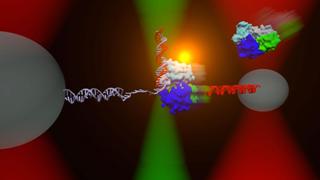Apr 20 2015
By combining two highly innovative experimental techniques, scientists at the University of Illinois at Urbana-Champaign have for the first time simultaneously observed the structure and the correlated function of specific proteins critical in the repair of DNA, providing definitive answers to some highly debated questions, and opening up new avenues of inquiry and exciting new possibilities for biological engineering.
 The DNA repair helicase UvrD can exist in an "open" (green, blue, cyan, and gray colored protein, upper right) or "closed" (middle) conformation. An instrument combining optical traps (red cones) and a single-molecule fluorescence microscope (green) is used to measure directly the relationship between these two structural states and their respective functions on DNA. Credit: Matt Comstock, University of Illinois at Urbana-Champaign
The DNA repair helicase UvrD can exist in an "open" (green, blue, cyan, and gray colored protein, upper right) or "closed" (middle) conformation. An instrument combining optical traps (red cones) and a single-molecule fluorescence microscope (green) is used to measure directly the relationship between these two structural states and their respective functions on DNA. Credit: Matt Comstock, University of Illinois at Urbana-Champaign
Scientists who study biological systems at the molecular level have over the years looked to the structure of protein molecules--how the atoms are organized--to shed light on the diverse functions each performs in the cell. The inverse is also true: observing the specific work particular protein molecules perform has provided important clues as to the conformation of the respective molecules. But until recently, our most advanced laboratory experiments could only investigate one at a time--static form or dynamic function--and from the results, deduce the other. This indirect method often doesn't provide definitive answers.
Now Illinois biological physicists Taekjip Ha and Yann Chemla have combined two cutting-edge laboratory techniques that together directly get at the structure-function relationship in proteins. Ha is well recognized for his innovative single molecule fluorescence microscopy and spectroscopy techniques. Chemla is a top expert in optical trapping techniques. Their combined method--simultaneous fluorescence microscopy and optical trapping--yields far more definitive answers to questions relating structure to function than either technique could independently.
Working in collaboration, Ha and Chemla each applied the above techniques in their laboratories, with conclusive results. The findings of these experiments have been published in two separate articles in the April 17 issue of the journal Science.
Chemla's lab team looked at the structure-function relationship in the helicase UvrD, a protein, found in the bacterium E. coli, that separates strands of DNA in need of repair by unwinding and unzipping them. There is an equivalent protein that performs the same vital process in humans. The first question Chemla's team investigated was how many UvrD proteins are required to perform this task--recent debates among scientists have the number at either one or two.
"The way we answered this," explains Chemla, "we put a dye molecule on each protein with fluorescence--so we could count them. Then we watched the unwinding with an optical trap. We found that a single UvrD helicase can do something--it unwinds the DNA, but not very far. It just goes back and forth a small distance, so we call it 'frustrated'. When we have two UvrD molecules, it seems to unwind much further and doesn't go back and forth as much."
Chemla's team also resolved one question on the structure-function relationship in UvrD. There are two distinct structures or states that are associated with UvrD, with the molecule organized in either an "open" or "closed" position. The function associated with each state has been debated among experts for several years.
"This time, we used smFRET (single-molecule fluorescence resonance energy transfer). We put two dyes on the molecule, and based on the distance between them, we could see one or another color of light, indicating whether the molecule was in the open or closed position. Then we used an optical trap to observe whether the molecule was unwinding the double-stranded DNA.
"We found that the molecules actually swiveled from open to closed and back again. As it turns out, the closed state unwinds the strands, using a torque wrench action. The open state allows the strands to zip together."